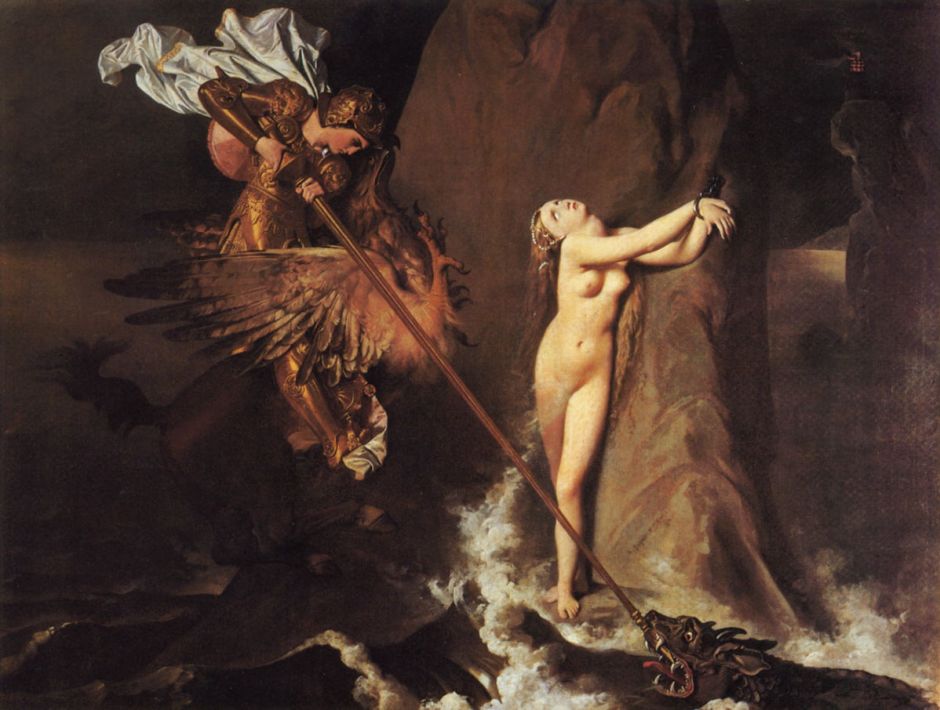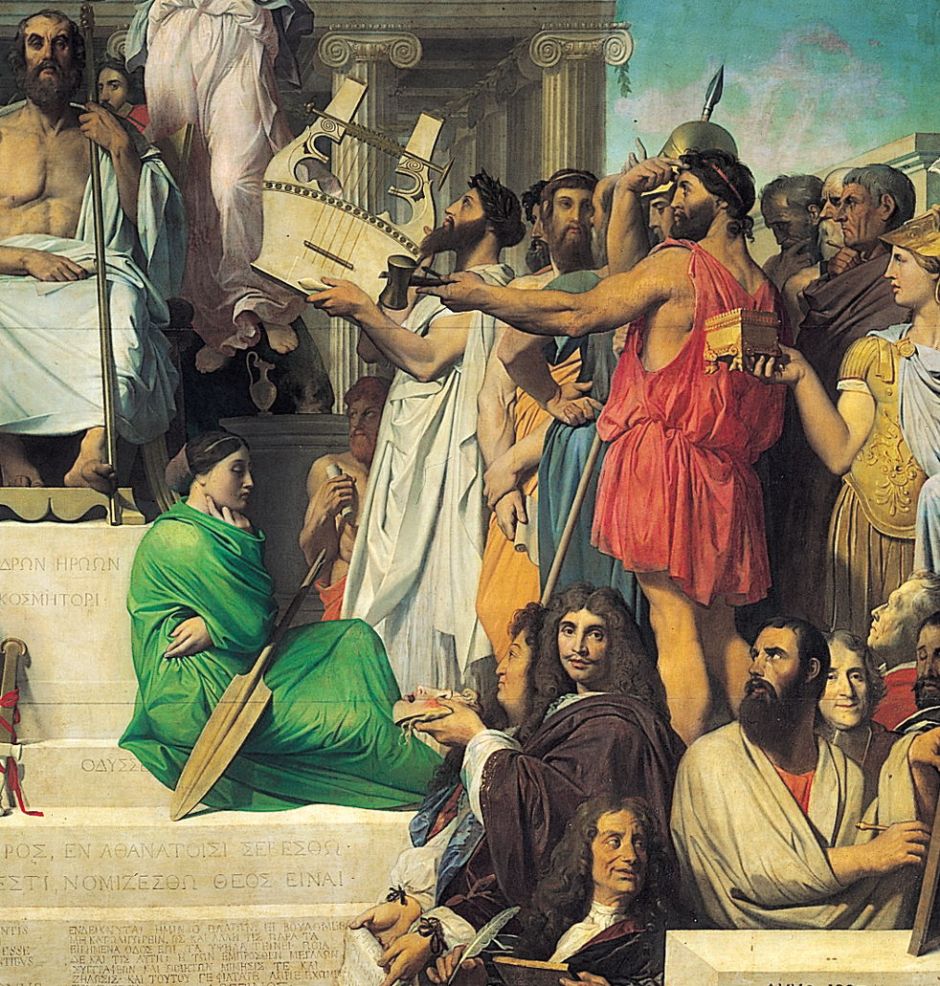Jean Auguste Dominique Ingres (1780–1867) was a prodigious painter and a talented violinist, who studied under the great Jacques-Louis David from the age of sixteen, and won the coveted Prix de Rome (for history painting) at his second attempt in 1801. He remains one of the most successful painters of the long succession who won that prize.
Although best known now for his later nudes, particularly his Odalisques, many of Ingres’ most brilliant narrative paintings were completed quite early in his career.
Oedipus and the Sphinx (1808, 1827)
The Sphinx guarded the entrance to the Greek city of Thebes, asking a riddle to determine whether to let people into the city. Those who got the answer wrong were apparently strangled by her. One version of this riddle is the question “Which creature has one voice and yet becomes four-footed, two-footed, and three-footed?” Oedipus solved this in his answer of humans, who crawl when a baby, walk on two feet as an adult, then walk with a stick when old. This painting shows Oedipus giving his answer to the Sphinx’s riddle.

Ingres painted this just two years after he had arrived in Rome as the recipient of the prize, working in a studio in the grounds of the Villa Medici. When sent back to Paris, it was criticised over its treatment of light, and lack of idealisation in the figures. In 1825, Ingres decided to develop it into a more narrative work, which he completed in 1827. This time it was well received.
His reworking enlarged the canvas, adding human remains at the lower left, and the contrasting background to the right. The facial expressions are eloquent, and body language well-judged.

Ingres’ work was a clear influence over the later painting of the same scene by Gustave Moreau (1826-1898), in his Oedipus and the Sphinx (1864), which appears to be based on a mirror image of the Ingres. However Moreau lost the facial expressions, particularly that of the Sphinx, which visibly weaked the narrative.
Romulus’ Victory over Acron (1812)
An avid reader of classical literature, Ingres chose several subjects which are poorly-known even to many scholars. In this case, it is one of the dusty corners from Plutarch’s account of the life of Romulus, co-founder of Rome.
The new city of Rome was very short of women, something which the Romans attempted to remedy by abducting the young Sabine women (as has been commonly depicted in paintings of the rape of the Sabine women). In retaliation for that offensive and treacherous act, Acron, king of the neighbouring Caeninenses tribe, made war on the Romans. Romulus led the Romans to annihilate Acron’s people, according to Plutarch:
Romulus, then, after making a vow that if he should conquer and overthrow his adversary, he would carry home the man’s armour and dedicate it in person to Jupiter, not only conquered and overthrew him, but also routed his army in the battle which followed, and took his city as well.

Ingres shows the victorious Romulus, just left of centre with Acron’s golden suit of armour, the defeated city burning in the background. Elements have been drawn from ancient art, but its frieze-like panorama feels a little frozen and stilted. Some of this may have resulted from Ingres’ use of tempera, in keeping with his subject.
Ossian’s Dream (1813)
The story behind this next youthful work is controversial today. In 1760, the Scottish poet James Macpherson published a cycle of epic poems in Scottish Gaelic. He claimed to have collected these from oral sources, rendering them into modern Gaelic. The central character in this epic was Ossian, recalling endless battles and unhappy loves from his earlier days.
These were rapidly translated into English and then, taking Europe by storm, into the other major languages of Europe. Their French translation was completed by 1777. When Macpherson died in 1796, so great was his fame that he was buried in Westminster Abbey. Early sceptics grew in number and influence, but even during the 1800s Macpherson still had many supporters. By the end of the twentieth century, the evidence that Macpherson had fabricated the whole story had become quite conclusive.

This painting shows an episode from Ossian’s epic, with the aged Ossian asleep on his harp, dreaming in monochrome of past wars and loves. It was perhaps appropriately commissioned for a bedroom which Napoleon was intended to occupy during a visit to Rome.
Roger (Ruggiero) Rescuing Angelica (1819)
Ariosto’s Orlando Furioso is an epic poem containing, among others, the tale of the knight Roger or Ruggiero. One day, when out riding near the coast of Brittany, on his hippogriff (half horse, half eagle), he finds Angelica chained to a rock on the Isle of Tears. He discovers that she was abducted and stripped by barbarians, who left her there as a sacrifice to a sea monster. As Roger approaches to free her, the monster appears from the sea, and Roger kills it by driving his lance in between its eyes. He then rides off with the rescued Angelica.

Ingres shows the story largely according to the original text, with Angelica’s head cast back almost unnaturally in her pleading look towards Roger. She appears to have a goitre, something which did not escape the critics of the day. Even so, the painting was purchased for King Louis XVIII and was installed in the Palace of Versailles from 1820.

Similar motifs – such as that of Perseus and Andromeda – have also been popular. William Etty (1787–1849) painted his Britomart Redeems Faire Amoret in 1833, and either or both may have induced John Millais (1829–1896) to attempt his one and only female nude, in his The Knight Errant (1870). In the latter case, the story of being stripped, tied up, and abused had left its classical roots, and mere robbers were to blame. The beautiful and naked victim still had to be rescued by a gallant knight, though.

Apotheosis of Homer (1827)
This last of the paintings I have chosen from Ingres’ career pays homage to Homer, gathering together all those figures whom Ingres had greatest respect for, and were major influences. Although its own narrative is very simple, it invokes and pays tribute to those who Ingres saw as the great masters of narrative.

The group is posed on the steps in front of a classical Greek theatre, in formal symmetric composition. Homer sits at its centre, being crowned with laurel by the winged figure of the Universe.

Among those standing at the left are Dante, Virgil, Raphael, Sappho, Apelles, Euripides, Sophocles (holding a scroll), and the personification of the Iliad (seated, in red); in the lower file are Shakespeare, Tasso, Poussin, and Mozart.

From the right are, among others, Alexander the Great, Aristotle, Michelangelo, Socrates, Plato, Hesiod, Aesop (under the lyre), and the personification of the Odyssey (seated, in green, with an oar); in the lower file are Gluck, Molière, and others less well-known today.
Conclusion
Shown at the Salon in the same year as Ingres’ Apotheosis of Homer was Delacroix’s radical narrative painting Death of Sardanapalus. As the last great classical narrative painter, Ingres must have felt that it was his empire which was in the throes of destruction.
References
Wikipedia on Ingres
Wikipedia on Oedipus and the Sphinx
Wikipedia on The Apotheosis of Homer
Wikipedia on Romulus’ Victory over Acron
Wikipedia on Roger freeing Angelica.

